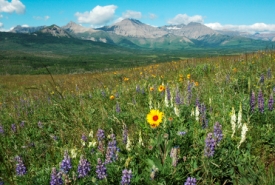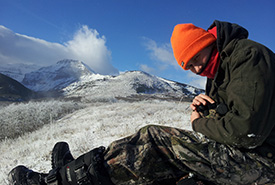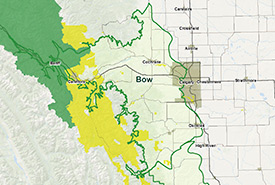Rocky Mountain Front Conservation Region

Wildflowers on Pine Ridge, Alberta (Photo by Bob Lee)
From the tops of the alpine peaks down to the foothills that roll into populated valleys, the Rocky Mountains support some of the most diverse ecology on the planet, including plant, animal and human communities.
The Nature Conservancy of Canada (NCC) has a long history in the Canadian Rockies. We are the largest and most successful land trust organization working in this region. NCC has directly conserved 110,500 hectares in Alberta and British Columbia. We have also assisted with the conservation of 211,650 hectares, working with partner organizations and various levels of government.
The foothills region to the west of Calgary comprises the Bow Natural Area, where the land transitions between parkland and the Rocky Mountains. Here, varied land use activities coexist with conservation. Grizzly bears and other iconic species continue to roam the eastern slopes of the mountains.
The southwestern corner of Alberta, where the province butts up against British Columbia and Montana, is a globally significant natural area. It includes the Crown of the Continent Ecosystem, Waterton Biosphere Reserve, Waterton–Glacier International Peace Park and Waterton Lakes National Park.
The Rocky Mountain Front contains large remnant tracts of foothills parkland grasslands, montane forest and important watershed and riverside areas. This area is under direct threat from most human activities.
The eastern slopes of the Rocky Mountains are a key area for maintaining wide-ranging carnivore populations. These slopes provide essential habitat for many species.
The Canadian Rocky Mountains can be said to represent the southernmost extent of true wilderness remaining in North America. Yet, even this is a wilderness divided. The division comes as a result of ever-increasing residential and industrial development that slices through this mountainous landscape. As a result, wildlife corridors are severed, and crucial habitat for many species is fragmented, including wide-ranging carnivores such as grizzly bear and grey wolf.
Conserving the Last Five Miles
The Last Five Miles is a project located in a small yet critical natural ecosystem in Alberta. It stretches from Longview to the U.S. border, along the eastern slopes of the Rocky Mountains. Only fragments of the land remain in a native state. Fewer than 150 years ago, these same lands stretched for a thousand miles to the east. But with settlement, development, growth and expansion, there remains little more than a thin band, seldom more than five miles wide, of wild lands.
The area features the richest diversity of carnivore, small mammal and hoofed mammal species in the central Rocky Mountains. Its valleys provide critical wildlife shelter and corridors. The front ranges are important for migrating raptors, such as hawks, eagles, owls and falcons. In addition to its mountain habitat, the Last Five Miles is also characterized by patches of deciduous and coniferous woodlands and open grasslands and is rich in species diversity.
The Last Five Miles is faced with serious threats due to human activity, such as rural residential development, industrial development, utility corridors and fire suppression. The highest-quality habitats are found in the same locations where human activity is also the highest, due to residential and recreational development, and increasing oil and gas activity. The effects of these activities on the landscape and habitat are far-reaching and not readily visible.
Featured projects
- The Rocky Mountain Front contains large remnant tracts of foothills parkland grasslands, montane forest and important watershed and riverside areas. This area is under direct threat from most human activities. Learn more about how we are protecting habitat in Canada's Rocky Mountains.
- The OH Ranch — a provincial Heritage Rangeland site — is both a natural and historic landmark in Alberta. NCC is committed to protecting 3,822 hectares of the ranchlands as a working landscape.
- The Waterton Park Front is prime habitat for grizzly and black bear, cougar, wolf, moose, elk, white-tailed and mule deer.
- The Waldron Conservation Project is a property in Alberta’s southern foothills. It is situated in a broad valley between the Bob Creek Wildland Park (the Whaleback) to the west and the Porcupine Hills Forest Reserve to the east along the eastern slopes of the Rocky Mountains.
- The Fleming Ranch is considered an ecologically significant grizzly bear corridor. The 118-hectare Fleming Ranch is mostly open areas of grassland interspersed with trees.
Come visit us
Visitors are welcome at many conservation areas protected by NCC. These special, natural places provide excellent opportunities for hiking, birdwatching, nature photography and other compatible recreation activities.
This year, get out into nature. Go to connect2nature.ca for information on visiting our properties in Alberta. We'd love to show you what we are able to accomplish, thanks to the generous support of our landowner partners and donors.

Chelsea Jaeger, Waterton Park Front, AB (Photo by Cory Turner)
Allowable activities on NCC properties and access
Allowable activities on NCC properties are defined by each property's management plan. There is no one-size-fits-all approach to the kind of recreation that visitors can engage in on our conservation lands. Some properties remain completely closed to the public, to protect the sensitive ecology that made the land so important to conserve. Other conservation areas can withstand a wide range of recreational pursuits without any harm coming to the natural habitat.
Find an NCC representative in this area:
Bow: Morgan Higginson
Castle-Crowsnest: Emilie Brien
Southern Foothills: Whitley Macaulay
Waterton: Lindsay Davidson
South-central Alberta: Adam Moltzahn






